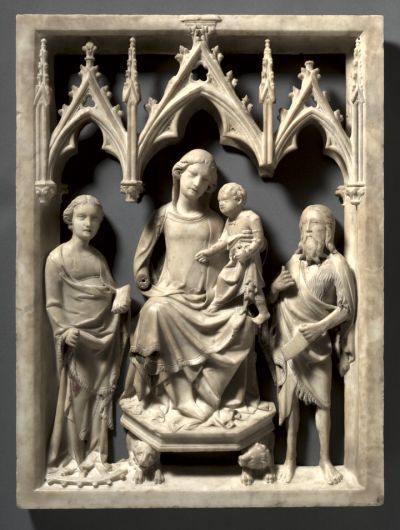In the 1300s, Italy was not Italy as we know it today. The peninsula was divided into city-states in which independent oligarchies governed their individual territories. The period saw the generally sustained growth of thriving urban centers teeming with mercantile wealth and an ever-growing population in which bankers, merchants, tradesmen, and craftsmen formed an emerging middle class. It has been suggested that Siena, Florence and other Tuscan cities were the birthplace of the free-market economy. At their centers rose large cathedrals, palaces and civic buildings, all requiring religious art and funded by communal governments or aristocratic rulers as symbols of authority, status and wealth.
Siena reached its golden age of architecture during the 14th century, when the city was able to erect many of the most important buildings that survive to this day. These include the Campo, the Palazzo Pubblico (then known as Palazzo dei Signori in reference to the city’s “Nine” governors), the Duomo, and the Torre del Mangia. This was also the period in which Sienese art flourished, with masterpieces such as Duccio’s Maestà.
In the late 1340s, a catastrophic wave of bubonic plague swept through Europe. Originating near Mongolia, it wiped out at least a third of the population. It was and remains the greatest single natural disaster in history. By May 1348, it had reached the thriving Italian city of Siena. Coming on top of a series of disastrous events, including banking crises, bankruptcies, crop failures, and hailstorms, the misery and mass deaths caused by the Black Death were seen as a terrible warning of the wrath of God for the moral corruption of man. For some, it even came to be regarded, quite literally, as the end of the world. The Republic of Siena existed for over 400 years, from the late 11th century until the year 1555. During the golden age of Siena, before the plague in 1348, the city was home to 50,000 people. Following the pestilence, the population dropped to about 14,000.
In Siena, as in other places, the Black Death had immediate and devastating effects on art and artists. The most obvious, of course, was that many painters and sculptors perished. The probable victims included Sienese masters such as Ambrogio Lorenzetti and his brother Pietro, the Sienese-influenced Florentine master Bernardo Daddi and possibly Lippo Memmi. It is almost certain that the Black Death would also have severely depleted future numbers of potential new artists as well as their patrons.
The primary sculptural program in Siena during the second half of the 13th and early 14th centuries was the construction and decoration of the Duomo, Siena’s cathedral, under the direction of the Pisan sculptor Nicola Pisano (1220-1284) and his son, Giovanni. At the beginning of the 14th century, Sienese sculpture was strikingly influenced by these great masters. Nicola was the first great innovator of medieval Italian sculpture. Nicola’s masterpieces include the marble pulpit in the baptistery at Pisa (1260); the pulpit in Siena cathedral (c. 1265-1268); and the fountain at Perugia (completed 1278), in which he was assisted by his two most significant followers, his son, Giovanni, and his pupil, Arnolfo di Cambio. While Nicola drew inspiration from ancient Roman sculpture, Giovanni Pisano’s illusionistic or pictorial expressionism was derived from Gothic realism. He added an expressive, taut beauty to the calm grandeur of his father’s style.
A marble relief sculpture dating to this very moment before the arrival of the plague in Siena is now preserved in the Cleveland Museum of Art. It depicts the Madonna and Child flanked by Saints Catherine of Alexandria and John the Baptist. Dating to just before 1348, this small sculpture measures about 27 by 20 inches and was sculpted by Giovanni di Agostino (1310-70). Agostino was, himself, the son of a Sienese sculptor and worked under Giovanni Pisano on the façade of Siena Cathedral. The Madonna and two saints appear within a rectangular frame and beneath a Gothic-arched canopy. However, the lions at the foot of the Madonna’s throne echo the famous pulpit by Nicola Pisano in Siena Cathedral. The relief would have been brilliantly painted and gilded, though today only paint fragments are visible. Illuminated by candlelight, the sculpture would have resonated with the faithful while suggesting the presence of the divine.
Agostino’s sculpture very likely belonged to a larger monument such as a tomb. However, the church to which it originally belonged is not known. Sienese art was well-known for its many representations of the Madonna. On the eve of the Battle of Montaperti in 1260, which resulted in the defeat of the Florentines, the city of Siena was officially dedicated to Mary. The Madonna was the city’s patroness. Her image flourished everywhere in Siena in the form of sculpture and panel paintings. The Cleveland sculpture is perhaps emblematic of Siena’s particular affection for Mary.
In the immediate aftermath of the Black Death in 1348, artistic activity virtually stopped. Major expansion projects in Siena, such as the Duomo, funded by civic authorities, were halted or drastically scaled back. Traditional levels of artistic patronage also declined, especially after 1355 when many wealthy and powerful families started to lose their influence. This decline forced those artists who managed to survive to travel and work further afield. Agostino’s sculpture, now in Cleveland, takes us to this very moment shortly before 1348, just before the arrival of the plague, an event that altered the degree and character of Sienese art forever.



